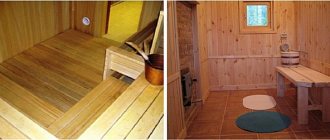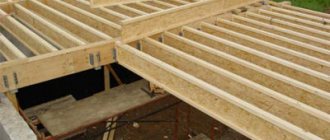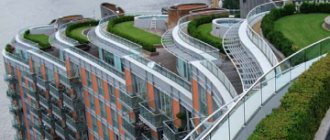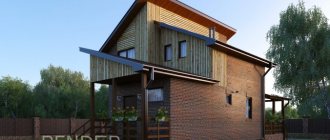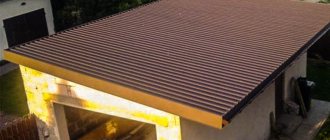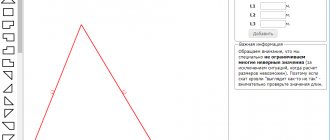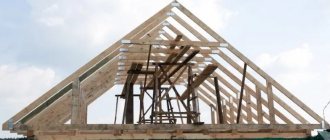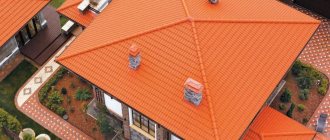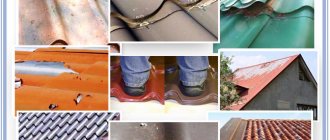When it comes to covering a flat roof, your options are limited and expansive. The bottom line is that traditional roofing materials like asphalt shingles, concrete tiles and corrugated metal simply won't cut it. That being said, flat roof systems such as PVC, TPO, EPDM rubber and others have their own pros and cons. So why can't you put traditional roofing materials on a flat roof? Well, technically you can, but they are almost guaranteed to leak! Systems such as asphalt shingles and concrete or clay tiles are installed by layering one course on top of another. They work in concert with the height of the roof to drain rainwater and snow as it accumulates there.
Since flat roofs have little space, water will seep in on its own under the shingles, eventually rotting the substrate and causing leaks in your interior space. Covering a flat roof is a completely different approach than a regular sloping roof. On a flat roof, you probably want to avoid any type of seams if at all possible. The biggest threat, of course, will be water finding access to even one hole or inadequately sealed seam in the roofing membrane.
Your main goal when installing a flat roof covering is to create a barrier that is impermeable to water. How do you make anything (other than a roof) waterproof? You can either use something ready-made, such as a tarp or plastic sheeting, or apply a substance to it to create a barrier, like you could with varnish or paint. Flat roofs should be treated the same way - either physically cover the roof with something ready-made, such as a PVC membrane, or apply some kind of waterproofing coating, resin or spray to it.
Content
Materials for roofing a flat roof cannot be selected based on the principle of “relevance in the new season.” All sorts of fashionable ondulins and flexible tiles are not suitable. And here's why: despite their decorative properties and undeniably good performance when working on pitched roofs, they are not capable of forming a continuous moisture-resistant carpet. And this is how a flat roof should be: absolutely sealed, with a minimum of seams - to ensure that moisture cannot seep under the layers of the roofing pie.
The following options are suitable:
- bitumen roll materials;
- polymer membranes;
- mastics.
All these coatings in the roofing carpet are dense enough to provide good waterproofing of a flat roof, and elastic enough to normally withstand temperature and mechanical influences. Moreover, each material has its own characteristics - in terms of functionality, installation method, durability, cost. Therefore, if you are planning to cover a flat roof, but do not yet know what, then we suggest that you familiarize yourself with the characteristics of the main materials.
Rules for using a flat roof
Operating a flat roof is no more difficult than a conventional gable roof. There are a number of rules, compliance with which during installation and further use will help extend the service life of the roofing:
- The roofing carpet should be protected from contact with organic solvents , gasoline or technical oil.
- The roof must be clean . Any debris, nails, forgotten pieces of reinforcement and wire left on the surface of the coating can compromise its integrity.
- It should be remembered that the bitumen-polymer materials included in the cake do not tolerate steam and temperatures above 45° .
- Regular inspection . During the melting of snow cover and autumn leaves, it is necessary to inspect gutters and funnels (at least twice a month).
Modern flat roof project Source archilovers.com
Option #1 - bituminous materials
These are materials in rolls that represent a durable base impregnated with oxidized or modified bitumen. Supplied in rolls, 10-30 m long, about 1 m wide.
The following types of bitumen materials exist:
- roofing felt;
- rubemast;
- stekloizol;
- euroruberoid or bitumen-polymer membrane.
Ruberoid
Roofing felt can be called one of the most common waterproofing coatings both in the Soviet period and now. Essentially, it is cardboard impregnated with bitumen. On one or both sides of the roofing material there is a protective bedding (sand, asbestos, talc, etc.). The durability of roofing material roofing is 5-10 years.
Ruberoid has minimal water absorption, so there is no doubt about its waterproofing properties. It is resistant to atmospheric conditions and mechanical influences, thanks to which it can withstand rain, hail, and snow debris.
Unfortunately, roofing felt is not resistant to extreme temperature influences: it melts in the heat (above 50°C) and cracks in the cold. Therefore, one cannot count on long-term operation without repairs. The average lifespan of a roofing material roof is 5-10 years. However, in defense of this material, we can remember that it is inexpensive, and its installation is quite simple. The rolls are rolled out on the roof and glued to the base with bitumen mastic with the seams carefully taped - that's all.
Rubemast
Rubemast, in fact, is the same roofing material, but an improved, more modern version of it. It is also made on the basis of roofing cardboard, but has a thicker bitumen layer on the underside. Due to this, rubemast is characterized by increased plasticity, it is less susceptible to cracking under mechanical stress and temperature changes. Therefore, its service life is longer than that of ordinary roofing felt - about 15 years.
Rubemast refers to weldable materials. Its installation is done by melting the bottom layer with a propane torch or solvents.
Stekloizol
Stekloizol (glass roofing material, steklomast) already belongs to slightly different materials, although outwardly it is not much different from roofing felt and rubemast. The only difference is in the filling. Fiberglass or fiberglass coated with bitumen is used as a base in glass roofing felt. A layer of granular bedding is applied on top of the material, and an easily meltable film is fixed underneath. Accordingly, the installation of glass mat is carried out using the fusing method.
Fiberglass, unlike cardboard, is not subject to rotting. They are the “reinforcement” of the material, holding flexible bitumen together and keeping it from cracking. Accordingly, stekloizol is more durable than roofing felt and rubemast. Its service life reaches 20 years.
Euroroofing material
Despite the advantages of all the listed materials, one step above them is Euroroofing felt - the most modern and functional bitumen coating. However, calling it bitumen is not entirely correct; it is more correct to call it bitumen-polymer. The composition of euroroofing felt includes bitumen modified with various additives, for example, pieces of rubber, which gives the final material special flexibility and waterproofing properties.
The basis of euroroofing material is fiberglass (canvas, fabric) or polyester (polyester). These materials are synthetic, do not rot, and are durable. A bituminous binder consisting of bitumen, additives and fillers is applied to both sides of the base. Protective layers of polymer film or bulk materials (shale, sand, talc, etc.) are fixed at the top and bottom of the canvas.
Installation of euroroofing felt is usually carried out by melting the lower bitumen-polymer layer with a burner and then gluing it to the roof. This installation method is typical for coatings with a polymer (indicator) film. Material with an existing self-adhesive layer is more convenient to install. Attaching it to the roof is as easy as shelling pears - just remove the protective film and glue the canvas to a previously prepared place.
You can learn about the characteristics of euroroofing felt using the example of Technoelast material from TechnoNIKOL by watching a short video:
Video description
The video shows how to properly lay a membrane roof, how it should be fastened, what fasteners are used for this:
See also: Catalog of projects of houses with a flat roof presented at the exhibition “Low-Rise Country”.
Mastic roofing
Mastic, or rollless roofing, is presented in three varieties on the market:
- bitumen mastic:
- bitumen-rubber;
- bitumen-latex emulsion.
The first two necessarily contain fibrous materials that perform the functions of a reinforcing frame. In the third, latex and a coagulator are added. It should be noted that mastic materials are applied only to the prepared surface, which is covered with fiberglass or fiberglass mesh. The last two materials are attached to the concrete base with cold bitumen mastic.
It should be noted that often in the process of repairing flat roofs, the underlay carpet is not laid if the old roll covering is in good technical condition. Mastics are simply applied to the surface to be repaired in a layer within 2-3 mm. And this is enough to talk about complete sealing of the roof structure.
Application of mastic roofing Source polmechty.ru
The list of advantages of mastic roofing includes the following:
- increased elasticity of the applied coating;
- 100% waterproofing ;
- range from -50C to +120C;
- increased strength and wear resistance;
- seamless application technology;
- simplicity and speed of the installation process.
The only difficulty is to distribute the mastic evenly over the surface to be treated with the same thickness. This requires experience and work skills.
And recommendations for applying this material for a flat roof:
- Do not pour on an uneven base;
- if the roof is wet ;
- in rainy weather.
Option #2 - polymer membranes
This type of material appeared in our country relatively recently, but has already gained enormous popularity. Polymer membranes are a qualitatively different type of roofing roll coverings that can withstand mechanical loads, temperature changes and are characterized by increased elasticity. Membranes are supplied in rolls up to 20 m wide and up to 60 m long. Such impressive sizes allow you to create coatings with a minimum number of joints and seams (which can threaten leaks).
Not the least role in the secret of the popularity of membrane roofs is their durability, which is far superior to all other options. Their service life is at least 30-50 years.
Installation of membrane roofs is quite simple, so it can be done in a short time. According to experienced roofers, installation of membranes is 1.5 times faster than laying bitumen roll coverings (under the same conditions).
Depending on the polymer that forms the base of the fabric, membranes are divided into 3 types: PVC, TPO and EPDM.
PVC membranes
The basis for PVC membranes is polyvinyl chloride with a “reinforcement” made of polyester mesh. To increase the elasticity of the material, volatile plasticizers (about 40%) are introduced into the PVC composition, which are gradually released after installation.
PVC membranes are available in different colors, but, unfortunately, they tend to gradually fade in the sun.
During installation, the PVC sheet is first secured mechanically (with telescopic fasteners), and then, laying the second sheet overlapping it, the joints are welded with hot air. Another option is diffusion welding. In this case, a solvent is applied to the surface of the membrane (at the seams), after which the panels are whipped together and a weight is placed on top.
TPO membranes
The production of TPO membranes is based on thermoplastic olefins. For reinforcement, fiberglass or polyester mesh is used. However, membranes of this type are able to work without internal support, so it is quite possible to find unreinforced TPO sheets on the market.
Since the material contains no volatile plasticizers, it is considered safer for the environment than its PVC counterpart. And the most frost-resistant than all other membranes (withstands up to -62°C).
The connection of TPO rolls into a monolithic roofing surface is carried out, as a rule, using a jet of hot air.
EPDM membranes
EPDM membranes are a roll material based on rubber reinforced with polyester mesh or fiberglass. It differs from other membranes in its increased elasticity (about 400%) and lower price.
In addition to pure EPDM, which has a rubber base, composite materials are produced. Their top layer is traditionally rubber, and the bottom layer is flexible bitumen-polymer.
EPDM is insensitive to bitumen and its modifications. Therefore, it is allowed to install membranes on top of an old bitumen roof, eliminating its dismantling and simplifying the repair process.
EPDM is laid by joining the seams with double-sided self-adhesive tape. This method is less reliable than the welded method used for PVC and TPO membranes, and therefore requires the additional use of adhesives. A ballast installation option is also possible, in which the membrane laid and fixed with telescopic fasteners is covered with pebbles, crushed stone, etc.
Interesting information about the characteristics, advantages and features of the production of EPDM membranes is presented in the following video:
Unused roof - simple and fast!
Construction does not require a strong roof base, which significantly reduces the cost of the project. This method is cheaper due to lower requirements for the rigidity of thermal insulation. Since there will be no foot traffic, the density of the insulation may be lower, and at the same time its price.
To install flat roofs from fused materials, it is enough to lay waterproof wooden flooring or plywood on top of the thermal insulation if the installation is carried out on beams. When the roof base is made of corrugated sheets and reinforced concrete, it is enough to lay rolls of bitumen waterproofing on top of the insulation and perform fusing in one or two layers.
The only point that needs to be taken into account during the operation of soft waterproofing of a flat roof is the reduced resistance of the roof to the weight of snow in winter. Therefore, in case of heavy rainfall, regular cleaning is recommended. For this reason, unused systems are installed in a small area and are cleaned without climbing onto the building.
Option #3 - mastics
The use of rolled materials, one way or another forming seams at the joints, is not a prerequisite for creating a soft roof. There is an alternative - roofing mastics. With their help, you can create an absolutely monolithic, seamless roof surface with a service life of about 3-10 years.
Mastic is a viscous fluid mixture that, when applied to the roof surface, hardens when exposed to air. The result is a homogeneous monolithic coating, without seams. In this case, we are talking about the use of mastics as materials for creating mastic roofs. But they are also used as adhesives when installing roofing carpet made from rolled materials.
Mastics contain organic binders, mineral fillers and special additives that improve the characteristics of the material. In the air, after being applied to the roof, the mastic hardens within an hour and turns into a smooth elastic film.
Depending on the type of application, mastics can be cold or hot. Cold ones are already ready for use; they can be applied to the roof without prior preparation. Hot – must be heated to a temperature of 160-180°C. Cold mastics have become more widespread, since their application is easier and does not involve the risk of burns. But hot mastics are more economical and harden faster, almost before our eyes.
Depending on the composition, mastics are:
- bitumen;
- bitumen-rubber (with rubber crumb);
- bitumen-polymer (with polymer components);
- polymer.
Bitumen mastics are the simplest in composition; they contain petroleum bitumen, filler and an antiseptic substance. This type of material is not recommended for mastic roofing due to the small operating temperature range.
By adding crumb rubber to bitumen mastic, manufacturers obtain another material more suitable for roofing - bitumen-rubber mastic. Once dry, it forms a durable and flexible coating that can withstand harsh operating conditions and extreme temperatures. Using bitumen-rubber mastics, you can not only create a mastic roof, but also repair many other types of rolled roofs.
Bitumen-polymer mastics are obtained by modifying petroleum bitumen with various polymers - rubbers, petroleum polymer resins, artificial waxes. After drying, they form a continuous flexible membrane with high waterproofing properties. They are also used for gluing and repairing rolled bitumen materials.
And the last option for mastics that can be used for self-leveling roofing and repairing roll roofing is polymer compositions. They do not contain bitumen; their functional properties are determined by the content of synthetic resins and polymers. Roofing membranes obtained using polymer mastics are characterized by elasticity, resistance to UV radiation, and durability.
Polymer compounds are rightfully considered the most durable. What features do they have? And how to apply them to obtain a reliable mastic roof? Watch the video - there are answers to these questions:
Device
Creating a flat roof is like making a multi-layer cake, in which roofing materials are layered on top of each other to provide the best waterproofing. This type of coating may include 3-9 layers laid in a certain sequence. However, the costs of arranging this type of floor are 3-4 times cheaper than constructing pitched analogues due to savings on lumber used to create the rafter frame. The structure of flat roofs is as follows:
Flat roof installation
- The base is treated with a special primer. Concrete slabs or wooden decking serve as the base for the flooring of flat roofs. They are first cleaned of dirt and debris, leveled, and all cracks on the surface are sealed. Then a primer layer is applied, which makes the structure of the material smoother and increases adsorption.
- Screed. A layer of concrete screed is poured onto the pre-prepared base of the flat roof to perform the slope. Sloping is the process of creating a slope to ensure the transfer of rain and melt water to drainage funnels.
- Thermal insulation coating. To prevent heat loss, insulation slabs are laid on the concrete screed. Typically glass wool, basalt fiber or extruded polystyrene foam is used. Some technologies make it possible to make a slope using backfill thermal insulation materials, including expanded clay.
- Screed. After the thermal insulation coating of flat roofs, another layer of screed follows, which protects the insulation from mechanical damage, deformation and wetness.
- Waterproofing. After the second layer of screed, a waterproofing coating is laid, which is created using modern roofing materials laid in several layers. Flat soft roofing is made from bitumen, polymer and bitumen-polymer coatings, installed by fusing or pouring.
Structure of bituminous materials
Note! A flat roof saves money spent on building a house, and also provides the opportunity to use additional space. The exploited ceiling can be equipped as a summer cafe, a greenhouse, a swimming pool can be installed in it, a lawn can be laid out, or even vegetables can be grown. In addition, projects of “smart houses” that provide themselves with electricity using solar panels installed on flat roofs are gaining popularity.
What material is better to choose?
After reading the information about the characteristics of each material, there is only one thing left to do - choose based on the desired functional features of the future roof. Do you want to lay the roof yourself? The easiest way to do this is using roofing felt or its modern built-up analogues. The most optimal material in terms of quality, ease of installation and durability is euroroofing felt, especially one that has a self-adhesive bottom layer.
It is not difficult to build a mastic roof, but its service life is limited and is usually 3-5 years. The highest quality polymer mastics last longer - up to 10 years. However, in any case, mastic is an excellent solution for budget construction and repairs, due to its low price.
If you choose a material based on the degree of durability and reliability, without paying attention to the price, then polymer membranes certainly win. Most likely, the installation of these coatings will have to be delegated to specialists, which also entails a general increase in the cost of the roof. But the membranes will last much longer (30-50 years) than any other analogues, so their increased cost is completely justified.

